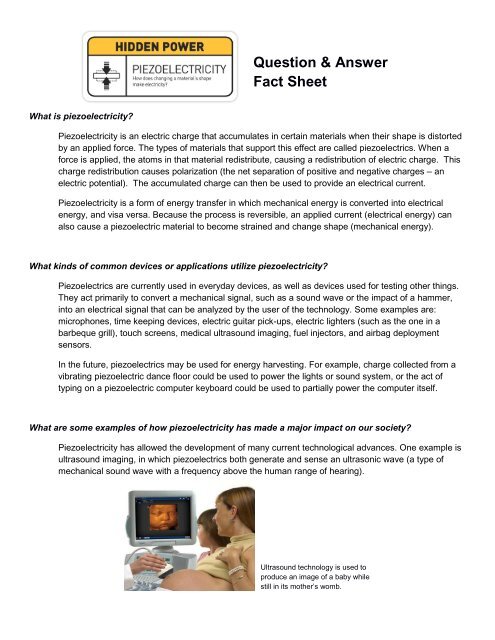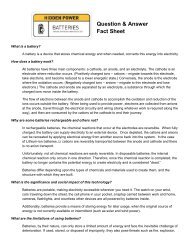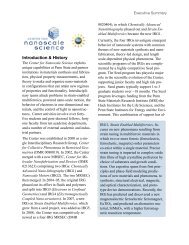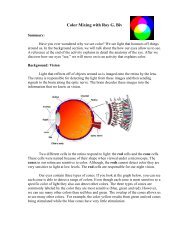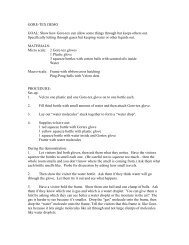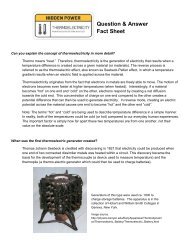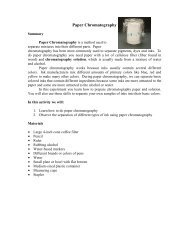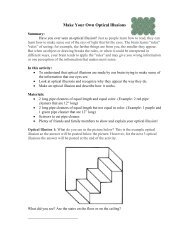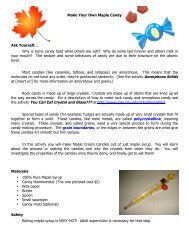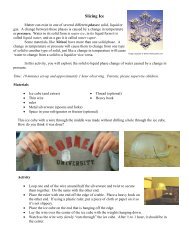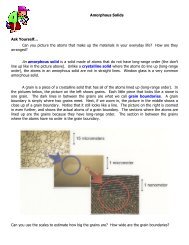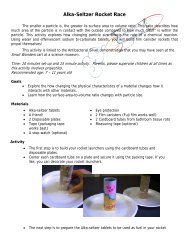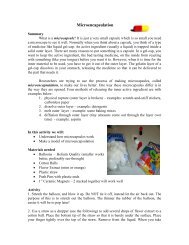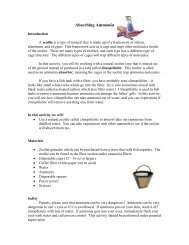Question & Answer Fact Sheet
Question & Answer Fact Sheet
Question & Answer Fact Sheet
You also want an ePaper? Increase the reach of your titles
YUMPU automatically turns print PDFs into web optimized ePapers that Google loves.
<strong>Question</strong> & <strong>Answer</strong><br />
<strong>Fact</strong> <strong>Sheet</strong><br />
What is piezoelectricity?<br />
Piezoelectricity is an electric charge that accumulates in certain materials when their shape is distorted<br />
by an applied force. The types of materials that support this effect are called piezoelectrics. When a<br />
force is applied, the atoms in that material redistribute, causing a redistribution of electric charge. This<br />
charge redistribution causes polarization (the net separation of positive and negative charges – an<br />
electric potential). The accumulated charge can then be used to provide an electrical current.<br />
Piezoelectricity is a form of energy transfer in which mechanical energy is converted into electrical<br />
energy, and visa versa. Because the process is reversible, an applied current (electrical energy) can<br />
also cause a piezoelectric material to become strained and change shape (mechanical energy).<br />
What kinds of common devices or applications utilize piezoelectricity?<br />
Piezoelectrics are currently used in everyday devices, as well as devices used for testing other things.<br />
They act primarily to convert a mechanical signal, such as a sound wave or the impact of a hammer,<br />
into an electrical signal that can be analyzed by the user of the technology. Some examples are:<br />
microphones, time keeping devices, electric guitar pick-ups, electric lighters (such as the one in a<br />
barbeque grill), touch screens, medical ultrasound imaging, fuel injectors, and airbag deployment<br />
sensors.<br />
In the future, piezoelectrics may be used for energy harvesting. For example, charge collected from a<br />
vibrating piezoelectric dance floor could be used to power the lights or sound system, or the act of<br />
typing on a piezoelectric computer keyboard could be used to partially power the computer itself.<br />
What are some examples of how piezoelectricity has made a major impact on our society?<br />
Piezoelectricity has allowed the development of many current technological advances. One example is<br />
ultrasound imaging, in which piezoelectrics both generate and sense an ultrasonic wave (a type of<br />
mechanical sound wave with a frequency above the human range of hearing).<br />
Ultrasound technology is used to<br />
produce an image of a baby while<br />
still in its mother’s womb.
The piezoelectric first converts an electrical input signal into an ultrasonic wave, which enters the<br />
patient’s body. The waves strike the tissues and organs of the body, reflecting back differently from<br />
each one. When the ultrasonic wave returns back to the device, the piezoelectric then converts the<br />
vibration back to an electrical signal. This signal is processed and the result is an image of the body’s<br />
tissues. The best piezoelectric materials today, such as lead zirconate titanate, contain the element<br />
lead. Researchers are now searching for non-lead based piezoelectrics that can match the<br />
performance of lead based piezoelectrics.<br />
Another technology made possible by piezoelectrics is sonar detection that is used to map the ocean<br />
floor. Tiny micromotors and drill bits powered by piezoelectrics can precisely and safely perform<br />
delicate surgical operations such as replacing opaque cornea of the eye, making these procedures less<br />
error prone than when they were reliant on the skills of a surgeon. Finally, piezoelectric actuators and<br />
sensors are used to control the tips of atomic force microscopes, which are so sensitive that they can<br />
image individual atoms.<br />
What’s happening on the cutting edge of research in this area right now?<br />
Engineers are working on increasing the maximum frequency at which a piezoelectric can vibrate. This<br />
will allow sensors and resonators that are used in applications such as microphones and medical<br />
imaging devices to be operated at a higher frequency, thereby producing sharper images.<br />
The greater the shape change you can get out of a piezoelectric from an applied electric field, the more<br />
potential applications there will be for that material. Scientists are trying to create new materials that<br />
maximize shape change with a minimum applied electric field. Similarly, scientists are also finding<br />
ways to maximize the electrical output for a minimum amount of applied load.<br />
In addition to searching for new piezoelectric materials that do not contain lead, researchers are<br />
exploring if other phenomena such as flexoelectricity can give the same performance as the current<br />
piezoelectrics. Flexoelectric materials can generate charge when bent or flexed. Unlike<br />
piezoelectricity, which exists only in certain material structures, this phenomenon exists in all materials.<br />
Piezoelectrics in the news:<br />
Ammu Kannampilly, "How to save the world one dance at a time,” ABC News: July 11,<br />
2008, http://abcnews.go.com/International/story?id=5358214&page=1<br />
Pawel Piejko, “New discovery might lead to laptops powered through typing,” gizmag: June 23,<br />
2011, http://www.gizmag.com/self-powered-battery-piezoelectrics-rmit-research/19007/


